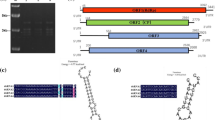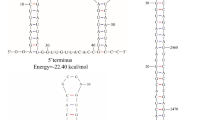Abstract
The entomopathogenic fungus Beauveria bassiana is used worldwide for biological control of insects. Seven dsRNA segments were detected in a single B. bassiana strain, RCEF1446. High-throughput sequencing indicated the presence of three mycoviruses in RCEF1446. Two were identified as the known mycoviruses Beauveria bassiana victorivirus 1 and Beauveria bassiana polymycovirus 1, and the novel mycovirus was designated as "Beauveria bassiana bipartite mycovirus 1" (BbBV1). The complete sequence of the BbBV1 is described here. The mycovirus contains two dsRNA segments. The RNA 1 (dsRNA 4) of BbBV1 is 2,026 bp in length, encoding a RNA-dependent RNA polymerase (RdRp) (68.54 kDa), while the RNA 2 (dsRNA 6) is 1,810 bp in length, encoding a hypothetical protein (35.55 kDa) with unknown function. Moreover, the amino acid sequence of RdRp showed the highest sequence identity of 62.31% to Botryosphaeria dothidea bipartite mycovirus 1. Phylogenetic analysis based on RdRp sequences revealed that BbBV1 represents a distinct lineage of unassigned dsRNA mycoviruses infecting fungi.


Similar content being viewed by others
References
Ghabrial SA, Caston JR, Jiang D, Nibert ML, Suzuki N (2015) 50-plus years of fungal viruses. Virology 479–480:356–368
Shi N, Yang G, Wang P, Wang Y, Yu D, Huang B (2019) Complete genome sequence of a novel partitivirus from the entomogenous fungus Beauveria bassiana in China. Arch Virol 164:3141–3144
Wang Q, Mu F, Xie J, Cheng J, Fu Y, Jiang D (2020) A single ssRNA segment encoding Rdrp is sufficient for replication, infection, and transmission of Ourmia-Like virus in fungi. Front Microbiol 11:379
Yu X, Li B, Fu Y, Jiang D, Ghabrial SA, Li G, Peng Y, Xie J, Cheng J, Huang J, Yi X (2010) A geminivirus-related DNA mycovirus that confers hypovirulence to a plant pathogenic fungus. Proc Natl Acad Sci USA 107:8387–8392
Wang Y, Zhao H, Xue C, Xu C, Geng Y, Zang R, Guo Y, Wu H, Zhang M (2020) Complete genome sequence of a novel mycovirus isolated from the phytopathogenic fungus Corynespora cassiicola in China. Arch Virol 165:2401–2404
Liu H, Wang H, Zhou Q (2021) A novel mycovirus isolated from the plant-pathogenic fungus Botryosphaeria dothidea. Arch Virol 166:1267–1272
Liu C, Li M, Redda ET, Mei J, Zhang J, Elena SF, Wu B, Jiang X (2019) Complete nucleotide sequence of a novel mycovirus from Trichoderma harzianum in China. Arch Virol 164:1213–1216
Huang B, Li CR, Fan MZ, Li ZZ (2002) Moleculer identification of the teleomorph of Beauveria bassiana. Mycotaxon 81:229–236
Kotta-Loizou I, Coutts RHA (2017) Studies on the virome of the entomopathogenic fungus Beauveria bassiana reveal novel dsRNA elements and mild hypervirulence. PLoS Pathog 13:e1006183
Okada R, Kiyota E, Moriyama H, Fukuhara T, Natsuaki T (2015) A simple and rapid method to purify viral dsRNA from plant and fungal tissue. J Gen Plant Pathol 81:103–107
Coutts RHA, Livieratos IC (2003) A rapid method for sequencing the 5′- and 3′- termini of double-stranded RNA viral templates using RLM-RACE. J Phytopathol 151:525–527
Katoh K, Rozewicki J, Yamada KD (2019) MAFFT online service: multiple sequence alignment, interactive sequence choice and visualization. Brief Bioinform 20:1160–1166
Kumar S, Stecher G, Li M, Knyaz C, Tamura K (2018) MEGA X: molecular evolutionary genetics analysis across computing platforms. Mol Biol Evol 35:1547–1549
Herrero N (2016) A novel monopartite dsRNA virus isolated from the entomopathogenic and nematophagous fungus Purpureocillium lilacinum. Arch Virol 161:3375–3384
Kotta-Loizou I, Sipkova J, Coutts RHA (2015) Identification and sequence determination of a novel double-stranded RNA mycovirus from the entomopathogenic fungus Beauveria bassiana. Arch Virol 160:873–875
Funding
This work was supported by the National Natural Science Foundation of China (Grant Nos. 31772226, 31471821 and 30770008).
Author information
Authors and Affiliations
Corresponding author
Ethics declarations
Conflict of interest
The authors have no conflict of interest.
Ethical approval
This article does not contain any studies with human participants or animals performed by any of the authors.
Additional information
Handling Editor: Robert H.A. Coutts.
Publisher's Note
Springer Nature remains neutral with regard to jurisdictional claims in published maps and institutional affiliations.
Supplementary Information
Below is the link to the electronic supplementary material.
Rights and permissions
About this article
Cite this article
Shi, N., Hu, F., Wang, P. et al. Molecular characterization of two dsRNAs that could correspond to the genome of a new mycovirus that infects the entomopathogenic fungus Beauveria bassiana. Arch Virol 166, 3233–3237 (2021). https://doi.org/10.1007/s00705-021-05239-z
Received:
Accepted:
Published:
Issue Date:
DOI: https://doi.org/10.1007/s00705-021-05239-z




